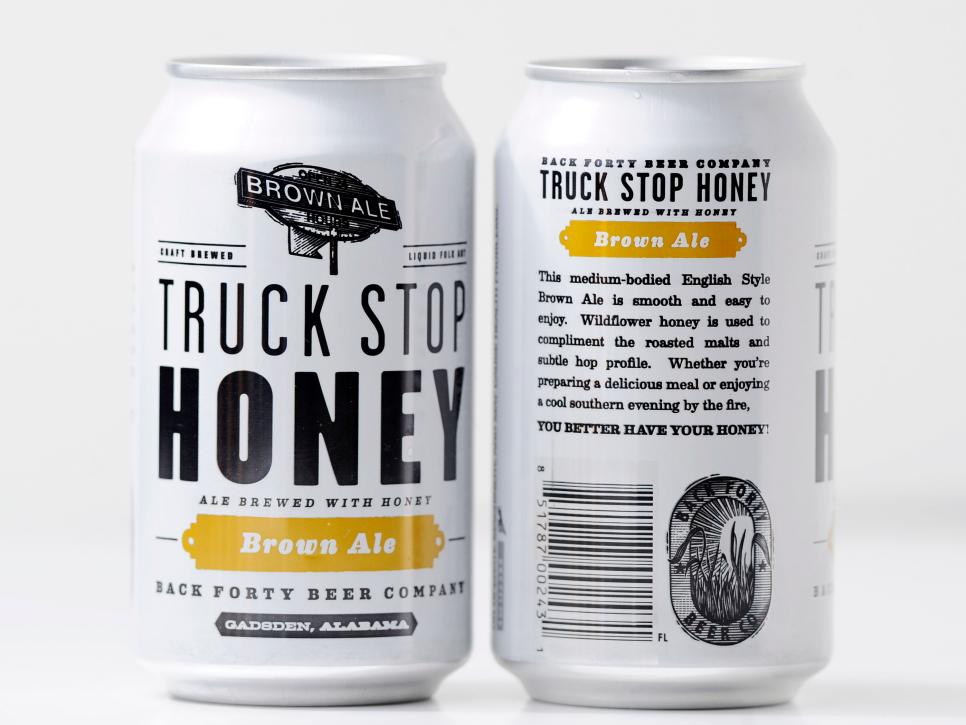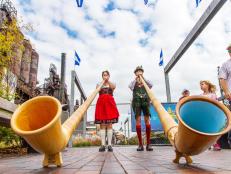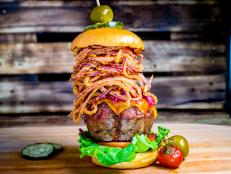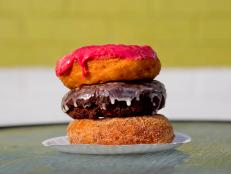50 States of Beer
Let's take a trip around the grand ol' USA in search of the most delicious beer the country has to offer. Enjoy this roundup of outstanding cold ones on us.

Photo By: Back Forty Beer Company
Photo By: Alaskan Brewing Co.
Photo By: Papago Brewing
Photo By: Marty Shutter
Photo By: Shutterstock / Lunacee Studios
Photo By: Left Hand Brewing Company
Photo By: Kent Falls Brewing Company
Photo By: Dogfish Head Craft Brewed Ales
Photo By: Under A Bushel Photography
Photo By: J. Wakefield Brewing
Photo By: Creature Comforts Brewing Co.
Photo By: Bryan Berkowitz
Photo By: Grand Teton Brewing Company
©Scratch Brewing Company
Photo By: 3 Floyds Brewing Co.
Photo By: Sarah Hedlund
Photo By: Tallgrass Brewing Company
Photo By: Against the Grain Brewery
Photo By: Parish Brewing Company
Photo By: Allagash Brewing Company
Photo By: Pabst Brewing Company
Photo By: Shutterstock / Lunasee Studios
©Shutterstock / Keith Homan
©Shutterstock / Kieth Homan
Photo By: Lazy Magnolia Brewing Company
Photo By: NoDerog
Photo By: Great Northern Brewing Co.
©Boiler Brewing Company
Photo By: Tenaya Creek Brewery
Photo By: Smuttynose Brewing Company
©Carton Brewing
Photo By: La Cumbre Brewing Company
Photo By: Brooklyn Brewery
Photo By: Fullsteam Brewery
Photo By: Drekker Brewing Co.
Photo By: Jackie O’s Pub & Brewery
Photo By: Prairie Artisan Ales
Photo By: Deschutes Brewery
Photo By: Yuengling Brewery
Photo By: Narraganset Brewing Co.
Photo By: Colin Robison
Photo By: Miner Brewing Company
Photo By: beall + thomas photography
Photo By: Spoetzl Brewery
Photo By: Wasatch Brewery
Photo By: Alchemist Brewery
Photo By: Hardywood Park Craft Brewery
Photo By: Fremont Brewing Company
Photo By: Mountain State Brewing Company
Photo By: Shutterstock / Keith Homan
Photo By: Melvin Brewing
Alabama: Truck Stop Honey Brown Ale, Back Forty Beer Company
This is the beer that helped launch Back Forty — and Alabama’s craft brewing scene — when it won a medal at the Great American Beer Festival in 2010. The not-so-secret ingredient that set it apart: Yellowhammer State wildflower honey.
Alaska: Spruce IPA, Alaskan Brewing Co.
Alaska’s oldest brewery has been pioneering fresh beer in the frozen north for more than 30 years. For this ale, they bolster piney hops with an abundant local resource: actual evergreen tips, harvested from local spruce trees.
Arizona: Orange Blossom Wheat Beer, Papago Brewing
Florida is America’s citrus powerhouse, but it doesn’t stock our supermarkets alone. California, Texas and, yes, Arizona also contribute. Papago’s fruited Orange Blossom Wheat is a creamsicle in a can, with a refreshing wheat base—perfect for sweltering evenings in the Grand Canyon State.
Arkansas: American Pale Ale, Ozark Beer Company
This golden brew owes its crisp, dry finish to the rye in its grain bill. In keeping with its home state’s aw-shucks attitude, it’s gimmick-free but executed flawlessly.
California: Anchor Steam Beer, Anchor Brewing
Anchor Steam has come close to extinction several times since Ernst F. Baruth and Otto Schinkel, Jr. opened their original San Francisco brewery in 1896. Somehow, though, Anchor Brewing has weathered the great San Francisco earthquake of 1906, Prohibition, and a national shift toward the mass-produced likes of Budweiser and Miller—which put the company out of business, temporarily, in 1959—to ship its California common beer, America’s first indigenous beer style, to supermarkets near you.
Colorado: Les Quatre Saisons, Left Hand Brewing Company
Coors built a brewing empire on Rocky Mountain snowmelt. These four seasonal releases from Longmont’s Left Hand—made with wildflower honey, Colorado wheat and barley, juniper and chokecherries—go deeper into Centennial State terroir.
Connecticut: Field Beers, Kent Falls Brewing Company
Yes, there are farms in Connecticut. Farms, in fact, that grow hops and malt for these tart, rustic farmhouse ales, which also incorporate locally grown oats, spelt, rye and wheat.
Delaware: SeaQuench Ale, Dogfish Head Craft Brewed Ales
Milton’s Dogfish Head is a brewery that isn’t afraid to take chances—whether that means adapting an Ancient Egyptian recipe for mass production or aging a flagship brown ale on Paraguayan palo santo wood. SeaQuench—a one-of-a-kind, ultra-refreshing blend of kolsch, gose and weisse beers flavored with sun-dried black lime, lime juice and sea salt—is the seafood-friendly house beer at the brewery’s Chesapeake & Maine restaurant in Rehoboth Beach.
District of Colombia: The Public, D.C. Brau Brewing Company
In 2011, D.C. Brau tapped the first keg of made-in-D.C. beer since the Eisenhower era. It’s still the city’s definitive brewery. Its most popular beer is The Public, a refreshingly straightforward American Pale Ale.
Florida: Miami Madness, J. Wakefield Brewing
Jam-packed with all-local mango, guava and passionfruit, this sour weisse has a cult following. Each fall, beer fanatics mob the brewery on release day to pick up their bottles (limit: two per person).
Georgia: Athena, Creature Comforts Brewing Co.
What’s better on a hot, muggy summer afternoon than a light, crisp sour beer? This is the state’s best example of the style. It goes down like lemonade.
Hawaii: Coconut Hiwa Porter, Maui Brewing Company
Maui Brewing makes island beers, using the likes of pineapple, passionfruit and homegrown coffee. This porter is the most popular of the bunch. It’s a lighter-bodied dark beer with just a hint of honest-to-goodness coconut.
Idaho: Ale 208, Grand Teton Brewing Company
Until 2017, all of Idaho shared one zip code—208. This session ale pays tribute to one of the country’s most spread-out states with an ingredient list that’s 100% Gem State.
Illinois: Seasonal Releases, Scratch Brewing Company
Chicago has an impressive brewing scene, but, on the southern side of Illinois, Ava’s Scratch Brewing Co. is exploring the Land of Lincoln from the roots up—literally. Scratch’s ever-changing beer lineup draws from the woods and gardens around the brewery, incorporating the likes of carrots, burdock root, hickory bark, sage, wild paw paws, maple sap and chamomile.
Indiana: Zombie Dust, 3 Floyds Brewing Co.
3 Floyds—in Munster, just outside Chicago—makes a few best-in-class pale ales, but none excite beer geeks like Zombie Dust. Despite the apocalyptic name, this hard-to-find brew is sunshine in a bottle, thanks to a heavy dose of radiant Citra hops.
Iowa: Pseudo Sue, Topping Goliath Brewing Co
Iowa’s favorite beer is another bright, citrusy pale ale with an epic name. Psuedo Sue’s mascot is Sue, the T. rex at the Field Museum in Chicago.
Kansas: Buffalo Sweat, Tallgrass Brewing Company
Tallgrass describes this popular milk stout as "liquid chocolate chip cookies." It’s a lighter-bodied session stout, which means that a six-pack can disappear just as quickly as a rack of fresh-baked goodies.
Kentucky: Bo & Luke, Against the Grain Brewery
Every batch of bourbon starts as beer—a fermented mash of corn, barley and wheat, rye, or both that’s then distilled into a high-proof spirit. Most of the time, that beer isn’t something you’d want to drink straight. This bourbon-inspired brew, though, is the exception. Made with smoked barley, rye and corn, in imitation of a bourbon mash, Bo & Luke is then aged in bourbon barrels—Pappy Van Winkle barrels—for even more flavor.
Louisiana: Canebrake, Parish Brewing Company
Parish has a dozen beers on tap at any given time, but this light, easy-drinking wheat ale takes up ninety percent of its brewing capacity. What makes it special? Louisiana cane syrup, which adds sweet-bitter complexity.
Maine: Sixteen Counties, Allagash Brewing Company
Maine’s most popular brewery hasn’t forgotten where it came from. This Belgian Pale Ale gets 100% of its ingredients from suppliers scattered across the 16 counties that make up the Pine Tree State.
Maryland: National Bohemian, Pabst Brewing Company
The Old Line State has a thriving craft beer scene—which has given rise to, among other innovations, Flying Dog’s Dead Rise Old Bay Summer Ale—but, still, no beer says Maryland like a cold Natty Boh. National Bohemian production left Maryland decades ago, but Baltimore still accounts for around 90% of sales. (It is, after all, the official beer of the Orioles.)
Massachusetts: Samuel Adams Boston Lager, Boston Beer Company
Jim Koch started one of the country’s first modern craft breweries with his great-great-grandfather’s lager recipe. Like Natty Boh in Baltimore, it’s iconic in Beantown—and the official beer of the local baseball team, the Red Sox.
Michigan: Two-Hearted Ale, Bell’s Brewery
Two-Hearted is often ranked among the best beers in the world, but you don’t need to wait in line for it. You can buy this balanced IPA—named after the Two-Hearted River, in Michigan’s Upper Peninsula—in bottle shops and grocery stores across the eastern U.S.
Minnesota: Grain Belt Premium, August Schell Brewing Company
If you’ve ever driven through Minneapolis, you’ve probably noticed the giant, 1940s-era Grain Belt sign on Nicollet Island. Grain Belt might not be the best beer in a state brimming with top-quality craft breweries, but it’s a Midwestern institution.
Mississippi: Southern Pecan Nut Brown Ale, Lazy Magnolia Brewing Company
Before craft beer washed over the South, the folks at Mississippi’s first brewery since Prohibition were bottling local flavor. This beer, made with whole roasted pecans, redefined Southern drinking.
Missouri: Budweiser, Anheuser-Busch
Budweiser is America’s beer. The original-recipe lager—which hasn’t changed since 1876—was the best-selling beer in the country until 2001, when it lost out to a competitor of its own creation: Bud Light.
Montana: Wild Huckleberry Wheat Lager, Great Northern Brewing Co.
Montana goes wild for native huckleberries each summer. Locals head into the mountains to fill their bags with fresh berries. Tourists fill their bags with huckleberry goodies ranging from pies, cakes and jellies to pancake mixes and gummy bears. Breweries get in on huckleberry season, too, but few use real huckleberries. That’s what makes this lager, flavored with huckleberry juice rather than extract, stand out. It tastes like wheat and wild berries, which makes it a refreshing pour on a hot, dry day in the mountains.
Nebraska: Nebraska Native, Boiler Brewing Company
Every ingredient in this wild ale comes from Nebraska—even the yeast, a funky strain harvested from a homebrewer’s apple orchard. Boiler adds extra local flavor in the form of sweet-and-sour native aronia berries.
Nevada: Local 702, Tenaya Creek Brewery
702 is the area code for Las Vegas. Vegas isn’t a craft beer capital—not yet—but this light-bodied session pale ale is an ideal shower beer for the tourists who fly in to enjoy the high life and the hardworking locals who make sure the fun never ends.
New Hampshire: Old Brown Dog, Smuttynose Brewing Company
On the Towle Farm in Hampton, Smuttynose has been brewing New Hampshire beers since 1995. Old Brown Dog is the standard-setting American brown ale—a native style of beer that’s richer and hoppier than the classic English brown.
New Jersey: This Town, Carton Brewing
You don’t want to drink an imperial stout on the Jersey shore. You want something light and refreshing, like Carton’s cooler-friendly This Town. It’s a crisp lager made in Atlantic Highlands by locals, for locals.
New Mexico: Molinillo Stout, La Cumbre Brewing Company
You don’t need a molinillo to make champurrado, but it helps. Mexicans have been using the wooden whisk to froth their cornmeal-thickened hot chocolate for centuries. This rich, full-bodied milk stout, flavored with cacao nibs and cinnamon, honors that tradition.
New York: Brooklyn Lager, Brooklyn Brewery
Brooklyn was a brewing capital in the 19th century—when beer was a hearty, blue-collar drink, and not so much a canvas for experimentation. This straightforward lager is a nod to that tradition, and famously well balanced.
North Carolina: Humidity, Fullsteam Brewery
Fullsteam literally invented the term plow-to-pint, referring to farm-rooted beers. This one is a refreshing pale ale brewed with a wheat-and-rye hybrid grain called triticale.
North Dakota: Broken Rudder, Drekker Brewing Co.
Just across the North Dakota-Minnesota border from Fargo, on the Red River, sits the Hjemkomst Viking Ship, a massive replica of a ninth-century Viking ship that local guidance counselor Robert Asp built with the intention of sailing it to Norway. Asp passed away before he could achieve his dream, but his children piloted the ship from New York to Bergen, Norway, in 1982, pushing forward even after a storm broke the ship’s rudder midway across the Atlantic. The story inspired this honeyed Irish red ale from the Viking brewers at Drekker.
Ohio: Paw Paw Wheat, Jackie O’s Pub & Brewery
Ohio’s forests are abundant with paw paws, native fruits that look and taste like mangoes, in the late summer and early fall. Most of them end up as treats for wild animals, or decaying on the forest floor, for lack of education. Some of them end up in this outstanding seasonal wheat ale, a tropical taste of the heartland from a foundational craft brewery.
Oklahoma: Standard, Prairie Artisan Ales
Prairie Artisan Ales probably owes its success as much to Colin Healey - who designs the brewery’s striking and often funny labels - as it does to his brother, founder Chase Healey, who, granted, originated some of the most interesting beers in the country in Tulsa, Oklahoma. Standard is, well, Prairie’s standard. It’s an everyday farmhouse ale that stands out for the label art alone.
Oregon: Red Chair NWPA, Deschutes Brewery
Named for a chairlift at Oregon’s Mount Bachelor ski resort, this so-called Northwest Pale Ale—an amber IPA—has the bold, hoppy character typical of a Pacific Northwest pale. That’s balanced, though, by a rich malt foundation that makes it appropriately hearty for ski season. It’s only on shelves from January through April.
Pennsylvania: Yuengling Traditional Lage, Yuengling Brewery
Yuengling, founded in Pottsville, Pennsylvania, in 1829, isn’t just the oldest continuously operating brewery in the United States. It’s also been owned and operated by the same family the whole time, beginning with German immigrant David Jungling and continuing through to current president Dick Yuengling, Jr., who took over in 1985. It’s American history by the bottle.
Rhode Island: Narraganset Lager, Narraganset Brewing Co.
From the 1930s to the 1970s, Narraganset was the best-selling beer in New England. For plenty of New Englanders, the beer—which is now coming back to Pawtucket, Rhode Island, after decades in the wilderness, during which time it was brewed in Indiana and New York—is the one that should be in every Yankee’s cooler.
South Carolina: Gose, Westbrook Brewing Co.
Not many Americans were drinking goses—sour beers brewed with coriander and salt—when Westbrook released its briny interpretation of the German style in 2012. Charleston caught on quickly, though, realizing that a sour, salty, low-alcohol beer was the perfect companion for a day on the water or a hot, lazy afternoon.
South Dakota: Chokecherry Brown Ale, Miner Brewing Company
You can’t get much more South Dakota than chokecherries—bittersweet prairie fruits that have been part of the local diet since the heyday of the Plains tribes. Just minutes from Mt. Rushmore, Miner uses them to bitter a unique brown ale.
Tennessee: From Tennessee With Smoke, Blackberry Farm Brewery
This beer is what happens when a Danish-by-way-of-New-York brewer and a Tennessee country ham master get together with their friends from one of America’s great luxury resorts. Jeppe Jarnit-Bjergso of Evil Twin partnered with Roy Milner of Blackberry Farm and Allan Benton of Benton’s Country Hams to create a limited-edition farmhouse ale with malts that spend seven days bathing in the hickory smoke of Benton’s ham house.
Texas: Shiner Bock, Spoetzl Brewery
Texans have been drinking Shiner since 1913. (Although it was a spring seasonal from 1913 until 1973, when the owners of the Spoetzl Brewery gave in to popular demand and began offering it year-round.) Each bottle still comes from the small town of Shiner, Texas, between Houston and San Antonio
Utah: Polygamy Porter, Wasatch Brewery
Utah is notorious for its strict alcohol laws. To this day, you need a liquor license to tap anything over 4% ABV by volume in the Beehive State. That’s less alcohol than you’ll get from a Keystone Light. The cheeky—and beloved—Polygamy Porter is shipped off at exactly 4%, which helps explain why it’s built such a following since 2001.
Vermont: Heady Topper, the Alchemist Brewery
You’re not likely to happen across a can of Heady Topper. Beer tourists make the pilgrimage to Stowe, Vermont, just to taste one of America’s most legendary IPAs. If you’re lucky enough to score a four-pack, follow the brewery’s two rules: Keep it cold until you’re ready to enjoy it, and sip it right out of the can.
Virginia: VIPA, Hardywood Park Craft Brewery
Hardywood’s so-called "Virgindia Pale Ale" highlights the agricultural bounty of the Old Dominion. It owes its elegant balance of flavors to both Appalachian hops and barley from the edge of the Chesapeake.
Washington: Field to Ferment, Fremont Brewing Company
Washington’s Yakima Valley is the hops capital of the U.S.—and, now, of the world, after recently surpassing Germany. Field to Ferment is a seasonal beer, brewed during the hops harvest in late summer, that highlights what’s fresh at the time of brewing, from grassy Centennial through piney Amarillo to tropical Citra.
West Virginia: Closs’ Harvest, Mountain State Brewing Company
This pumpkin beer stands out. A rich red ale, it gets its fall flavor from wood-roasted Tucker County pumpkins—and not a lot of autumn spice.
Wisconsin: Spotted Cow, New Glarus Brewin
New Glarus makes some of the best fruit beers in the United States—including the Belgian Red, with a pound’s worth of Door County cherries in each bottle, and the Serendipity, loaded with apples, cranberries and cherries. Spotted Cow, though, is as iconic in its home state as fried cheese curds or brandy old-fashioneds. It’s how New Glarus has become the 25th-largest brewery in the country without selling a single beer outside Wisconsin.
Wyoming: 2x4 DIPA, Melvin Brewing
At 10% ABV, this double IPA is a Wyoming-strength beer. The rest of the country likes it, too. It’s won gold medals at the Great American Beer Festival, the North American Beer Awards, and the World Beer Cup.






